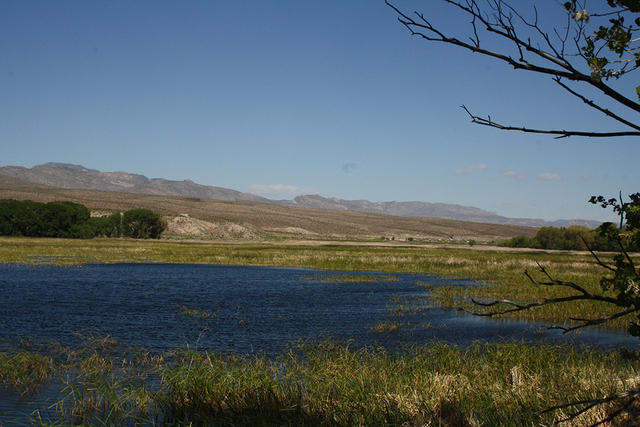Pahranagat offers sight-seeing aplenty

Pahranagat National Wildlife Refuge, just south of the ranching community of Alamo, encompasses 5,382 acres of lakes, marshes, meadows, riparian areas and open desert. The three largest bodies of water in the refuge are Upper Lake, Middle Pond and Lower Lake, fed by thermal springs.
Abundant water makes Pahranagat a busy resting and dining spot on migratory birds’ journeys north and south. It’s part of the Pacific Flyway, stretching from Alaska and Canada to Mexico. Furthermore, there are many species living there year-round. All of that makes Pahranagat an excellent place for bird watching, where more than 300 species have been recorded. And early November is an especially good time to do it; the migration is well underway, yet temperatures are just about ideal for human visitors, neither too chilly nor too warm. It is located at an elevation of about 3,350 feet, so expect temperatures about 5 to 10 degrees cooler than Las Vegas.
One special avian visitor, which you might get to see in November, is the greater sandhill crane. These magnificent birds can be 5 feet tall and weigh up to 14 pounds. They stop there this time of year for one or two days on their journey south and then again in February and March when they return north. They are a silvery gray color with a distinctive patch of red on their crown above the white cheek. They also have a unique curved feather pattern on their rump.
In fall, you might also see great blue herons, snowy egrets, Canada geese and a variety of other waterfowl. Winter also brings tundra swans, golden eagles and bald eagles, red-tailed hawks, northern harriers and Cooper’s hawks. To get a glimpse of a bald eagle, look at the tall trees that line the lake. They sit and swoop down to catch a fish once in a while. Hawks are usually looking for small game and cruise the open meadows in search of prey.
Other wildlife in the refuge includes beaver, coyote, kit fox, mule deer and mountain lion. I have seen beaver lodges in Upper Marsh for years.
Pahranagat’s waters are a good place to use shallow-water, shore-hugging craft such as canoes and kayaks and other craft powered by human arms or electric motors. Fishing is permitted all year, although the peak season has passed, and a part of the refuge called North Marsh is closed to fishing and boating during waterfowl season.
The refuge is also home to many historic sites. Once home to the Paiute people, there are numerous rock art sites, including pictographs and petroglyphs. Pahranagat in Paiute means “valley of shining water.” There is also a historical building built by pioneers, the Walden House, thought to be constructed around 1864.
Pahranagat is close enough to the Las Vegas metropolitan area to make a good day trip, but staying a night or two allows for nature’s best shows, at dawn and dusk. Camping is allowed on the eastern shoreline of Upper Pahranagat Lake.
Also, the nearby farming community of Alamo offers surprising luxury for such a small settlement, at The Cowboy’s Dream, a unique, purpose-built bed-and-breakfast where every room is individually designed and furnished in an authentic Western motif. The website, cowboysdream.com, advises that reservations are required at least three days in advance if you expect dinner. Call 775-725-3500.
Alamo also boasts at least two more conventional accommodations, the Alamo Inn at alamoinn-nevada.com or 775-725-3371, and the Windmill Ridge Bed & Breakfast at wind-mill-ridge.com or 775-725-3686.
DIRECTIONS
From Las Vegas, take Interstate 15 north and drive about 21 miles, exiting onto U.S. Highway 93, the Great Basin Highway. Drive north for about 69 miles and go left to the signed refuge headquarters. For the refuge’s upper lake, drive a few miles farther on U.S. 93 and go left.
Deborah Wall is the author of “Great Hikes, A Cerca Country Guide” and “Base Camp Las Vegas: Hiking the Southwestern States,” published by Stephens Press. She can be reached at deborabus@aol.com.